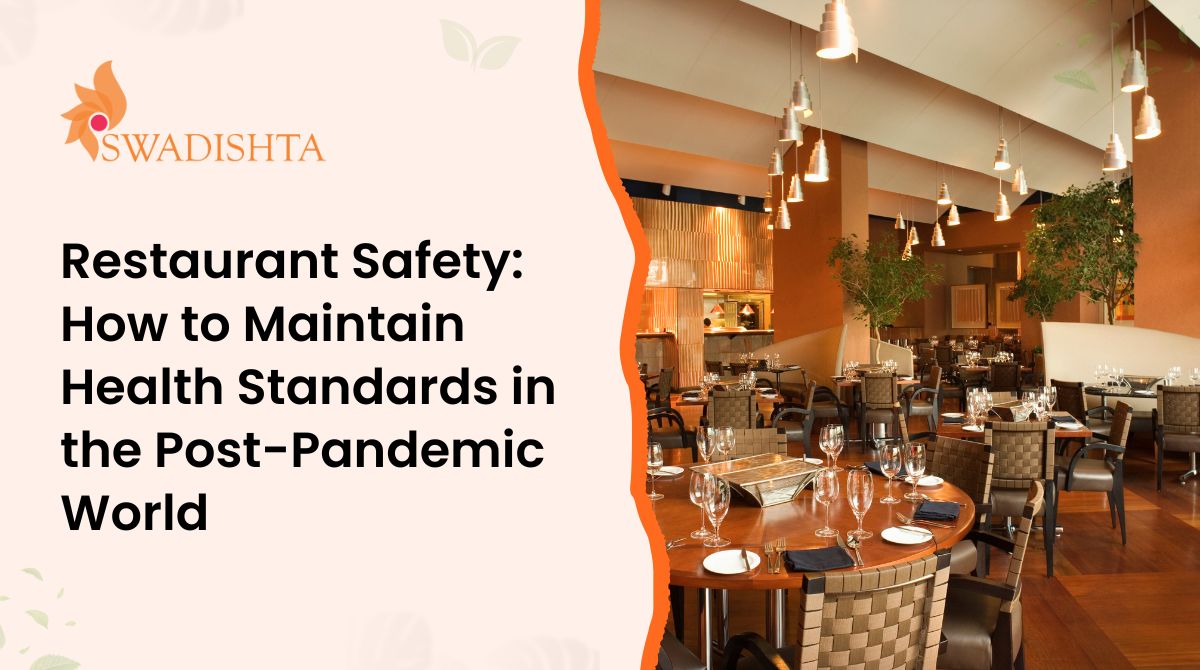The restaurant industry has faced major shifts due to the COVID-19 pandemic, and maintaining health and safety standards is now more important than ever. Customers want to feel safe when they dine out, and restaurants must adapt to meet these expectations while also complying with evolving regulations. In this post-pandemic world, restaurant safety goes beyond hygiene—it encompasses everything from food safety to customer experience and even staff well-being.
Here’s how restaurants can ensure health standards are maintained in the new normal:

1. Enhanced Cleaning Protocols
- Daily Disinfecting : High-touch areas such as door handles, menus, restrooms, and tabletops should be disinfected multiple times a day. Many restaurants are even opting for UV light sanitizers and fogging machines to ensure thorough cleaning.
- Kitchen Hygiene: Kitchens should be sanitized more frequently, and employees must follow strict protocols for hand-washing, glove use, and equipment sterilization.
- Tables and Seating: After each customer leaves, tables, chairs, and surrounding areas should be cleaned with disinfectants, including condiments or menus placed on tables.
2. Contactless Ordering and Paymen
- Online Ordering: Offering digital or contactless ordering via apps, QR codes, or self-service kiosks
- Cashless Payments: Encouraging customers to use contactless payment methods, such as mobile wallets or card payments, reduces the need for handling cash and limits physical interaction.
3. Social Distancing Measure
- Table Spacing: Adjust seating arrangements to maintain the recommended distance between tables. If possible, limit the number of tables to ensure adequate space for guests.
- Staff Interaction: Train employees to maintain physical distance from customers where possible. This can include limiting staff contact with guests by using digital menus or placing orders through servers who maintain distance.
- Waiting Areas: Mark off designated spots for waiting customers to ensure proper distancing while they wait to be seated. Install barriers if needed to reduce physical contact.
4. Air Quality and Ventilatio
- Improved Ventilation: To reduce airborne pathogens, restaurants should invest in upgraded HVAC systems that improve airflow and circulation. If possible, open windows or opt for outdoor dining to enhance ventilation.
- Air Purifiers: In indoor dining spaces, air purifiers with HEPA filters can help to reduce the spread of germs, especially in crowded or high-traffic areas like kitchens and dining rooms.
5. Employee Health and Safety
- Health Screenings: Require daily health screenings for employees before their shifts, including temperature checks and symptom self-assessments. Ensure employees stay home if they’re feeling unwell.
- Protective Gear: Continue to provide staff with PPE, such as masks, gloves, and face shields, especially for roles in direct contact with customers or food preparation.
- Vaccination and Training: Encourage staff to get vaccinated and offer ongoing training on safety protocols, including the correct use of PPE, cleaning procedures, and how to handle high-risk situations.
6. Clear Communication with Guests
- Visible Safety Measures: Customers will feel more confident if they see safety measures in action. Display signs explaining your sanitation procedures, mask policies, and other safety protocols.
- Pre-Visit Guidelines: Use your website, social media, or reservation platforms to communicate any changes to the dining experience, such as adjusted hours, menu changes, or requirements like reservations for limited seating.
- Transparency: Be transparent about the safety measures you are taking, and provide reassurances to your customers that their health and safety are your top priority.
7. Menu Adjustments for Safety
- Limited Menu Options: Offering a smaller, streamlined menu can reduce kitchen complexity and time spent handling multiple ingredients, lowering the chance of contamination.
- Pre-Packaged Condiments: Instead of communal condiment stations, opt for single-use packets or individual portions to limit contact between customers and staff.
8. Promoting a Safe Delivery Experience
- Contactless Delivery: If your restaurant offers delivery services, ensure the process is contactless. Consider leaving food outside customer doors or using delivery apps with no-contact options.
- Safe Packaging: Ensure delivery packaging is sealed and tamper-proof, and encourage drivers to wear masks and gloves to protect themselves and customers.
9. Adapting to Local Regulations
- Stay Updated on Guidelines: Health and safety regulations can vary greatly by location and change over time. Stay informed about local government guidelines regarding COVID-19, and adjust your protocols accordingly.
- Be Prepared for Quick Adjustments: Have contingency plans in place in case of sudden changes, such as another lockdown or new restrictions on indoor dining. Flexibility will be key to keeping your operations running smoothly.
10. Customer Education
- Educational Campaigns: Regularly educate your customers on the safety protocols you’re following. You can do this via your website, social media platforms, or even signs placed around the restaurant.
- Encourage Responsible Behavior: Politely remind customers to wear masks where required, follow social distancing guidelines, and follow your restaurant’s rules to create a safer dining environment for everyone.
Maintaining Restaurant Safety at Swadishta
At Swadishta, we are committed to ensuring the highest standards of health and safety for both our guests and staff. In line with the latest guidelines and best practices in the restaurant industry, we strictly adhere to enhanced cleaning protocols, maintain social distancing, and ensure that our team is well-equipped with the necessary protective gear. We’ve also embraced contactless ordering and payment options to provide a safe and seamless dining experience. Additionally, our staff undergoes regular health screenings, and we continue to prioritize ventilation and air quality within our restaurant. At Swadishta, we believe that safety and comfort go hand-in-hand with great dining, and we take every measure to provide a secure environment for all our patrons. You can always trust that we’re doing our part to keep you safe while you enjoy our delicious offerings. For more information, please visit our menu and safety updates.

Conclusion
As the world moves into a post-pandemic era, maintaining high health standards in restaurants is crucial not only for customer safety but also for building trust. By focusing on cleanliness, promoting contactless interactions, prioritizing air quality, and supporting your staff’s health, you can ensure that your restaurant provides a safe and enjoyable experience for all guests. Taking proactive measures to keep your dining space secure will demonstrate your commitment to guest well-being and position your business as one that values both safety and service.


